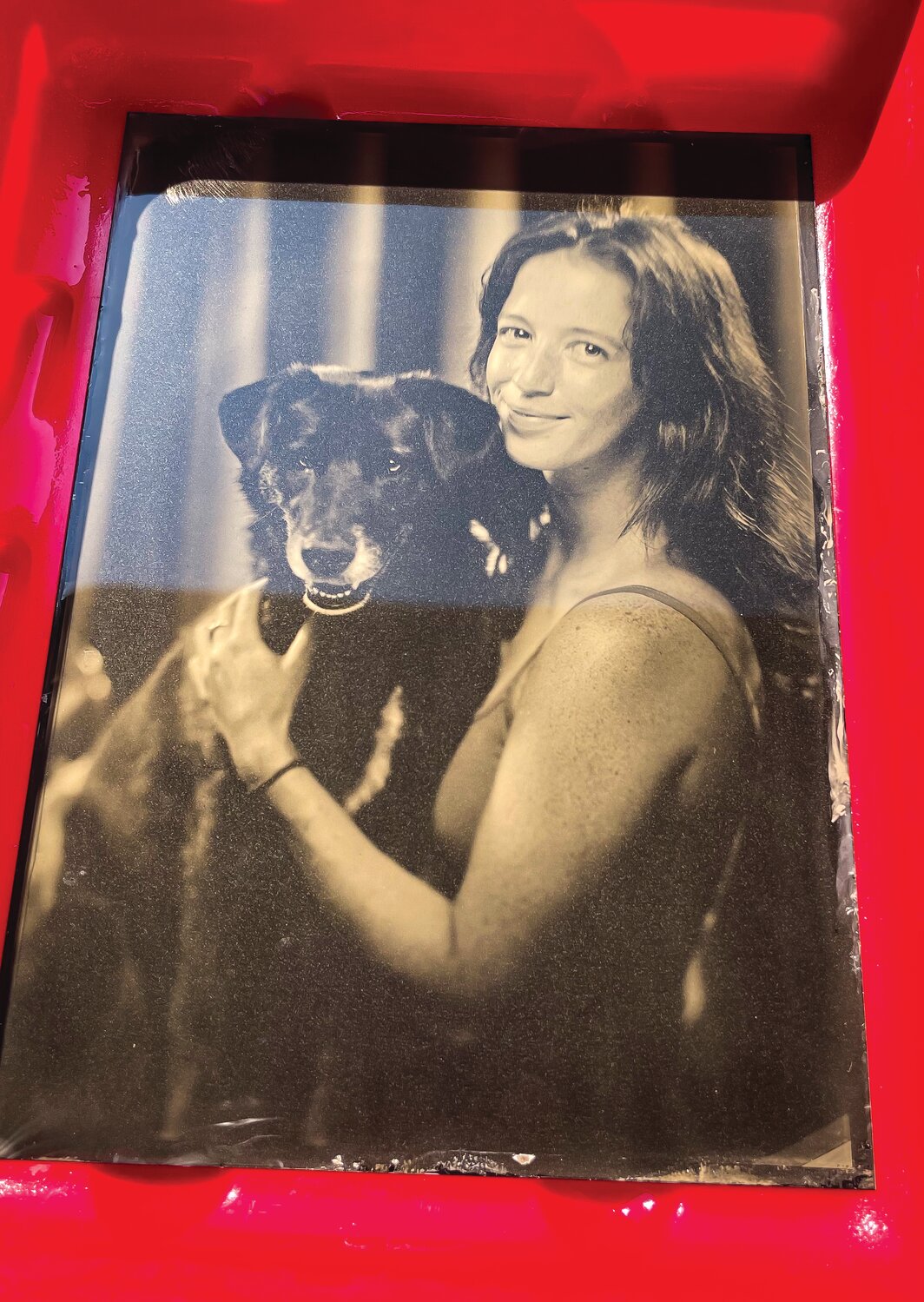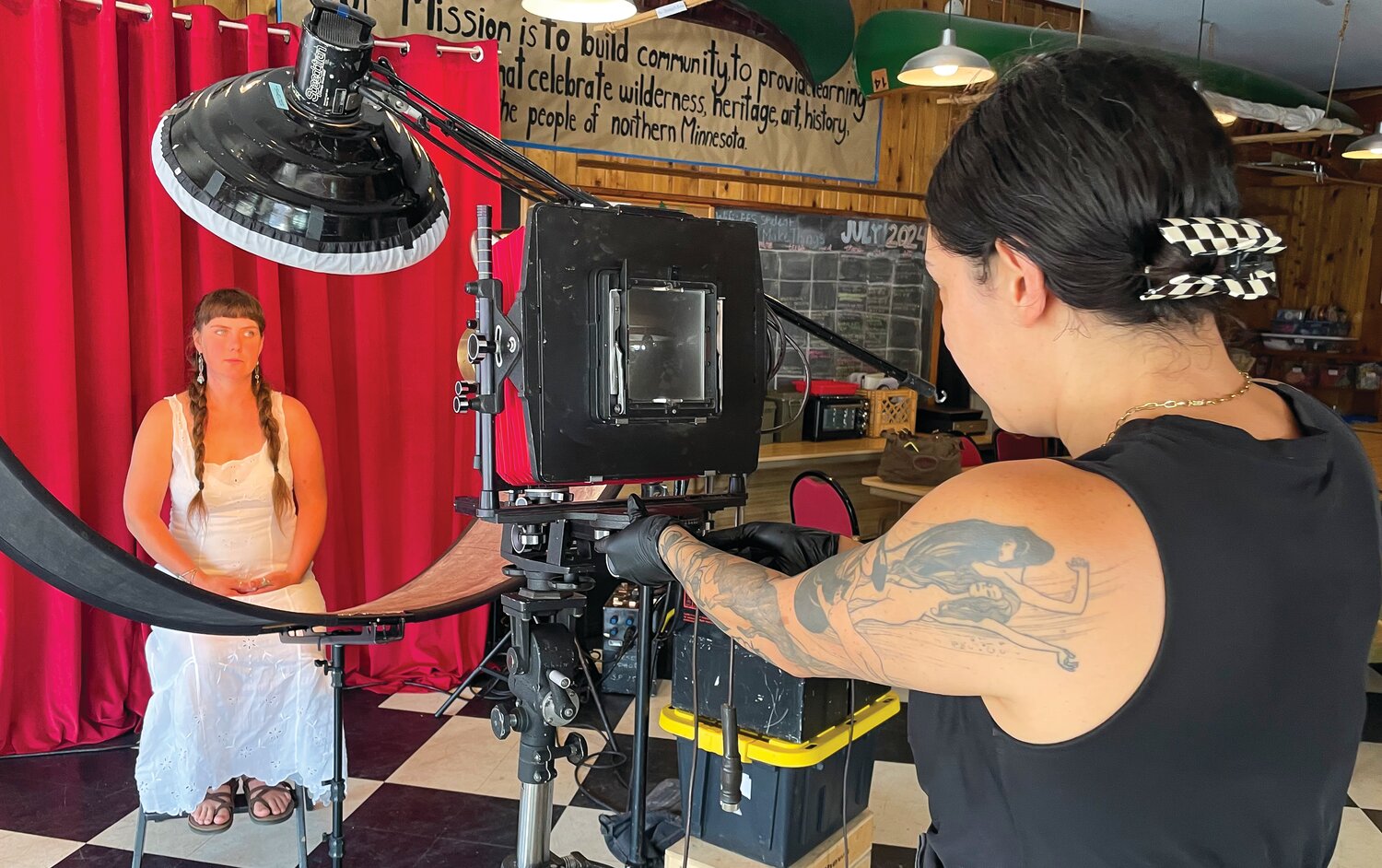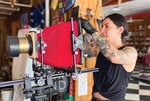Support the Timberjay by making a donation.
The old-fashioned way
Artist revives one of the earliest forms of photography to capture timeless portraits
ELY- Bailey McLinn-Belehar, of Ely, was more than excited to get a chance to preserve a likeness of her 14-month-old son Everett during a tintype artist’s pop-up studio session at the Ely Folk School over Blueberry Festival weekend.
“This is just magic,” she said, watching the image slowly darken to reveal her son’s sparkling eyes and smile as it emerged from the pan holding the still wet black and white portrait.
Bailey said one of her relatives has a similar tintype portrait of his great-grandfather, a treasured family heirloom.
Tintype is a form of photography called wet-plate, as the photograph is created on a thin metal plate, which is coated in a wet silver halide solution (hence a wet plate). This type of photograph dates back to the 1850s, and was used extensively to document the civil war, and then was a favorite for portraits. These photographs can last over 150 years, and the quality of the image is far greater than anything that can be captured by a regular present-day camera.
Carla Alexandra Rodriguez is a St. Paul-based artist, who fell in love with wet-plate photography while a student at the Minneapolis College of Art and Design, where she graduated in 2011. She was born and raised in Houston, Texas, but came to the Twin Cities for college and stayed.
While studying large format photography, which uses film, she took a class in historical photographic processes.
“I watched someone do a wet plate and I was just sold,” she said. While there was no one at the college to teach her the techniques needed, she was determined to figure it out for herself.
“I am making my own film, essentially,” she said.
That was over 10 years ago, and since then she has worked to learn the processes involved, and slowly assembled the equipment required.
“It’s expensive and there is a steep learning curve,” she said. There is a small community of tintype photographers, she said, and they are a very happy to provide tips and other information to fellow artists. This isn’t a type of photography that can be learned from a book.
“There is not one way to do these photographs,” Rodriguez said. “I’ve been taking workshops and networking with other artists online.”
The hands-on nature of tintype photography is more like drawing or painting, than simply taking a photo, she said, something that really attracted her to the craft.
A Minnesota State Arts Board grant helped her purchase her first equipment. Her camera was built using a military-surplus surveying camera.
But it took another year of experimenting to get consistent images.
“I am still learning,” she said. “This is a very humbling process. There are many variables and finesse involved.”
“Tintypes often have a mind of their own,” she said. “Each image is unique.”
She named her art studio, BLKK Hand, after one of the side effects of working with the silver nitrate solution that creates these lasting images, her black-stained hands. The silver in the emulsion solution turns black when exposed to the light, and it doesn’t wash off, just slowly wears off with your old skin. And no matter how careful one is, she said, you always manage to get some of the liquid on your hands and fingers.
Back in the 1800s and early 1900s, photographers using wet-plate methods traveled from town to town offering portrait sessions, and with her pop-up studio events, she is continuing this tradition.
“I love traveling,” she said, “but it is a lot of shlep around.”
Rosa Oesterreich, a professional midwife who lives in rural Ely, stopped by to get a portrait taken to use for her new business cards. Rodriguez worked with her to get the type of professional image she was looking for, which did involve taking a series of two different tintypes.
And Caroline Herman, who spends her summers in Ely, stopped by for a portrait session with her dog Juniper.
Herman had heard about the opportunity from a friend. And she liked the idea of “having something special for us, that will last forever.”
Rodrigeuz counts many of her photography subjects as friends.
“This process has brought a lot of people into my life,” she said. “This is how I make friends. It is a real way to connect with someone.”
The images, once developed, are treated with a chemical “fixing” solution and then allowed to dry. Rodriguez then will coat them with shellac, which creates a highly-durable and shiny surface. So, clients have to wait a few days to take home their finished tintype. She also creates a high-quality digital scan of each image, to share with her clients, since this process creates a single photograph.
Rodriguez will be spending more time in Ely in the future (her partner now works year-round at the Voyageur Outward Bound School and is buying a house in Ely), so she hopes to be setting up some more pop-up studio events in the future. She is also thinking about having a booth at next year’s Blueberry/Art Festival. Find out more about the artist and her work at https://www.blkkhand.com/, or follow her on Instagram.











